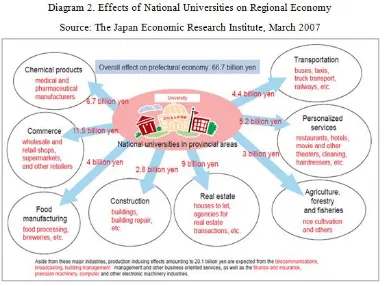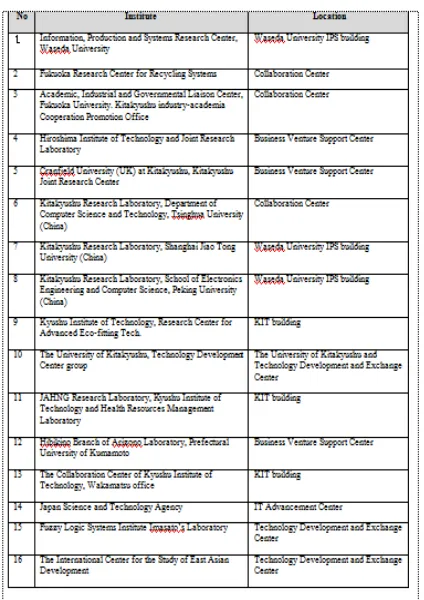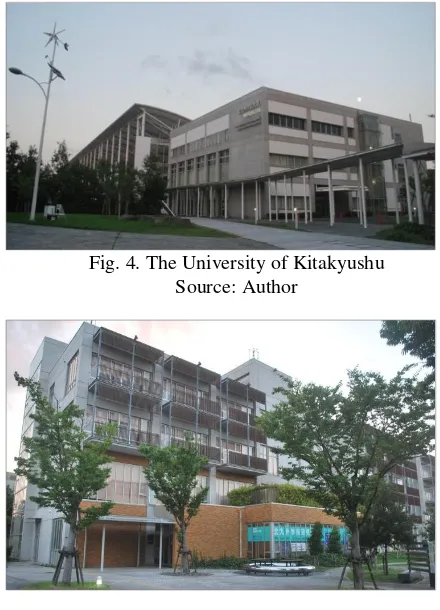©Universitas Bandar Lampung 2013
The Importance of Education Facility as Sustainable Urban
Generation Tool
Fritz Akhmad Nuzir
1*, Haris Murwadi
2and Bart Julien Dewancker
3 1Doctoral Student at University of Kitakyushu, Japan and Permanent Lecturer at University of Bandar Lampung, Indonesia
2 Permanent Lecturer at University of Bandar Lampung, Indonesia 3
Professor at University of Kitakyushu, Japan *
email: u3dbb003@eng.kitakyu-u.ac.jp
address: Graduate School of Environmental Engineering, University of Kitakyushu, Hibikino 1-1, Wakamatsu, Kitakyushu, Japan
(Received April 2013, Accepted July 2013)
Abstract-Education value has always been a part of urban development since the age of ancient Greece, Rome, India, and China. It is recognized as the changing factor into a civilization society. Every society in the world has at least the simplest form of education which is at home. Meanwhile many others have been utilizing this value to a greater purpose of the community through the development of education facilities. One of the education facilities that contribute substantially to the development of an urban area is higher education institute or university.According the Brundtland Commission, sustainable development is development that meets the needs of the present without compromising the ability of future generations to meet their own needs. Therefore a sustainable urban generation tool is a feature that is expected to generate the development of an urban area in order to meet the definition above. Sustainable development has many criteria such as economy (growth of annual income), social (growth of public participation and awareness), and the most important, environment (growth of facility/infrastructure and ecological management). Japan as a country which has limited natural resources, has been experiencing aging population and declining on birthrate. Therefore in order to maintain its economic growth, Japan is using its science and
technology advantages as its main generator.
Meanwhile, it is acknowledged that science and technology are the outcomes of education process. So at the end of the day, education in Japan plays important roles in the development of the economy and the society. This paper aims to acknowledge the importance of education facility as sustainable urban generation tool by studying the development of the economy, social, and environment of the case study area which is the Kitakyushu Science Research and Park in Kitakyushu (Japan).
Keywords-- urban, education, sustainable, economic, social, environment, generator, development
1.INTRODUCTION 1.1.Background
It was not without any reason that an educational facility was first completely built in Masdar City, Norman
Foster’s ecocity. As Foster[2] had mentioned in one of his latest essays that in Masdar, a university was planned to be in the central location of the city masterplan and very important to conduct researches that will result the finding of more sources of renewable energy. However the establishment of this university was a very energy-consuming work.
Previous study that was done by Frassoldati [3] introduced that from 1990 onwards, local governments of Italian cities had proposed the development of education facility in a form of research and science center, the term
“center” was often replaced by the term “park”, as an
urban regeneration strategy to embrace native potentials and develop their competitiveness. Yet she also mentioned that others had also argued that the so called science park was only becoming one of luxurious symbols of real estate development of which it did not really contribute to the urban development compare to the effort, time and budget wise, of establishing one.
From the explanations above, it can be understood that the introduction of education facility in urban development could be proved important since it could bring the creation and or rejuvenation value to the development. But this benefit comes along within considerable time and budget investment which could also prevail and delay the development of an urban area from its success. Therefore the question is how important the existence of education facility as the main generator in a sustainable urban development.
1.2.Problem Statement
©Universitas Bandar Lampung 2013
well implemented. The connection between the three factors above is inseparable.
Meanwhile Briggs[1] also proposed that these three factors, economic, social and environmental are integrated within a system to achieve a concept of intelligence city. Still according to Biggs that the city intelligence will assess the urban ability to manage its demands and needs and to adapt the inevitable changes within its development, while the city sustainability will assess the urban ability to sustain and maintain its development without harming the surrounding region and the future condition.
Diagram 1. Sustainable and Intelligence Urban Factors Source: Author
The concept of intelligence city does not literally relate to the introduction of education facility into the urban development. However it suggests us that in order to discuss the significance of education facility as sustainable urban development, changes in economy, social and environment would be the key factors to contribution to generate sustainable development in the area, studies for the impacts on social and environmental as the other key factors are required.
1.3.Objective and Target
Objective of this paper is to at first introduce the utilization of education facility focusing on the higher education facilities e.g. university, graduate school, research institute, etc., as one of the tools to generate sustainable urban development and its impact in a case study area. And the target of this paper would be to create a base for argument in regard to the importance of education facility as a sustainable urban generation tool.
II. METHOD 2.1. Case Study Area
The case study area is the development area of Kitakyushu Science and Research Park (KSRP) that specifically located in Hibikino area, Wakamatsu ward, Kitakyushu city, Fukuoka prefecture.
2.2. Survey and Site Visit
Survey and site visit are required in order to get current information about present situation and condition of the case study area. Photographs, brochures, and newsletters are mainly acquired within this step.
2.3. Data Collection and Analysis
The most important step is to collect existing statistical data from local authorities or research groups. Upon receiving it, the data would be analyzed and concluded. The data reflects the key factors such as:
a.
Economy: demographics (population and age),investment and employment, income, business starts and closures, land use, and transportation.
b.
Social: events (formal, community, cultural), conferences and other educational activities, publication and news, promotion, organization, researches and studies.c.
Environment: masterplan of KSRP, stages of development plan, assessment report, quality and quantity of green open spaces, biodiversity changes, climate report, energy management report.2.4. Study Literatures
General understanding of the issue and the case study area could be gained by studying relevant and up-dated literatures including previous researches and studies. 1.1.5. Questionnaire
In order to support and strengthen the result of this paper, a questionnaire would also be distributed to the projected contributors to inquiry some general information within the key factors mentioned in the previous chapter.
III.RESULTS
3.1. Education`s Role in Japan
Nowadays there are limited natural resources in Japan. Its population is aging with declining birthrate. Therefore to keep internationally competitive upon continued economic growth and development, Japan needs to strategically utilize the science and technology infrastructure that the nation has built and link it with the development
©Universitas Bandar Lampung 2013
Diagram 3. Percentage of New Graduates Entering Employment (Source: MEXT)
Higher education institutions, including universities, graduate schools, research institutes, etc., are the driving forces in advanced education and research in Japan. These institutions highly take part in the society and economy development by conducting advanced research and development of human resources within the society. The real and direct products of it are the advanced science and technology infrastructures which later create economic values as well. Diagram 3 ultimately shows that the higher education graduates are highly preferable to be employed in Japan nowadays.
Since the year of 2002 MEXT has also been establishing the system of industry-academia-government collaboration. In the past, the industry-academia-government collaboration made positive impacts by its regional science and technology promotion policies which are further advanced with the aim of establishing sustainable regional innovation systems.
3.2. Kitakyushu City as an Industrial City
The city of Kitakyushu7 has been established in February 1963 by the merger of five cities which are Moji, Kokura, Wakamatsu, Yahata and Tobata. Based on information from the Kitakyushu Industry and Economics Bureau Trade Promotion Division8 as per 2008, the area size of Kitakyushu is 487 square kilometers and the population reaches to 986,998 inhabitants, including 11,303 foreigners. In 2003, the city’s total GDP is JPY 3,436.9 trillion.
Kitakyushu once contained one of the four largest industrial zones in Japan with the establishment of companies such as Governmental Yawata (Yahata) Iron and Steel Works in 1901, which manufactured materials such as steel, chemical, metal and ceramic. At present, automobile-related industries are being established in this city.
However, in recent years, high-technology industries such as industrial robots and biotechnologies are being manufactured. Some new regional movements are also heading to the advancement and diversification of regional industries such as joint research through cooperation of business, academic and governmental circles and development of new products by a
multi-professional group. Additionally, three ports (sea port, airport and e-port) were constructed and new industries including the automobile, semiconductor and environment-related industries were promoted in order to regenerate the city of Kitakyushu.
Fig. 1. Strategic Position of Kitakyushu Source: www.kk-j.org
3.2. The Kitakyushu Science and Research Park
In order to enhance the collaboration between industry and education institution, the city of Kitakyushu established the Kitakyushu Science and Research Park (KSRP) in April 2001. According to Manufactured Imports and Investment Promotion Organization (MIPRO)9, the Kitakyushu Science and Research Park (KSRP), located in the Hibikino area, district of Wakamatsu, Kitakyushu, is a cluster of universities and research institutes that play a central role in the development of advanced science technology.
The Kitakyushu Industry and Economics Bureau Trade Promotion Division also provided statement that KSRP is an academic hub, implementing the goal of the advancement of science and technology. As per May 1st 2011, KSRP educates 2,354 students including 525 overseas students, employs 150 teaching staff members, 162 researchers, and contains 60 enterprises.
Fig. 2. The KSRP area viewed from above Source: www.ksrp.or.jp
©Universitas Bandar Lampung 2013
international research and development institutes and universities, enabling them to make full use of all that is available at KSRP. The government also sets up goals for the KSRP which are to become a core academic research center in Asia and to promote creation of new industries and further development of technology.
3.3. Education and Industry Institutions in the KSRP Based on FAIS10 database, at present, there are 4 (four) universities located in the Kitakyushu Science and Research Park which can be seen from the following table.
TABLE 1. THE KSRP AREA VIEWED FROM ABOVE SOURCE: WWW.KSRP.OR.JP
Integrated with the universities, there are also research institutes in the KSRP listed in the following table.
TABLE 2. RESEARCH INSTITUTES IN THE KSRP SOURCE: WWW.KSRP.OR.JP
In order to collaborate with these academic institutions, the industry is represented by companies which are based in different buildings such as 10 companies in the Collaboration Center, 3 in the Semiconductor Center, 9 in the IT Advancement Center, 25 in the Business Venture Support Center and 7 in the Technology Development and Exchange Center. Thus in total, there are 54 industrial companies in the KSRP as per August 1, 2011. The KSRP also provides some public facilities, such as library, cafeteria, exhibition hall, etc.
©Universitas Bandar Lampung 2013
Fig. 4. The University of Kitakyushu Source: Author
Fig. 5. Collaboration Center Source: Author
Fig. 6. Public Library in the KSRP Source: Author
3.4. Development of the KSRP
The development of the KSRP is taken place in the western part of Wakamatsu ward and in the northwestern part of Yahatanishi ward. The total area of development is approximately 335 hectares. It is planned to have a daytime population of 12,000 people and housing of 4,000 units. The construction is divided in stages which are:
a.
1st Stage Project which covered the area of approximately 121 hectares. It was started in the 1995 and completed in the 2006 by the Urban Renaissance Agency (URA)b.
2nd Stage Project which covered the area of approximately 136 hectares. It was started in the 2002and is expected to be completed in the 2014. This stage is developed by the City of Kitakyushu itself.
c.
3rd Stage Project is planned to cover approximately 68hectares and is already under construction now.
d.
River improvement which will cover around 10hectares.
Fig. 7. Map of the Present KSRP facilities Source: www.ksrp.or.jp
Nowadays in regard to the time schedule, the development of the KSRP is already approaching the end of the 2nd Stage project. Yet some setbacks are already foreseen as likely the physical construction is not yet synchronized with the initial development plan, as shown in Figure 7.
Despite of the setbacks, some progresses made by the KSRP are acknowledged by MEXT from the period of 2001-2008 such as the number of cases of joint researches is increasing from 93 to 273 annually; the number of applications for a patent is increasing from 53 to 248 also from 2001-2008; and external funds acquired is increasing substantially from 423m yen to 2,029m yen, which show considerable increase.
Still according to MEXT, products of researches conducted in the KSRPE are used by the public, such as new environmental-friendly fire hydrant, which was developed in collaboration with a local company and including their related products, have been produced with sales performance of about 2.5 billion yen in the year of 2008.
IV.DISCUSSIONS 4.1. Changing of Population in the KSRP
©Universitas Bandar Lampung 2013
Diagram 4. Population in the KSRP (Hibikino area) Source: www.ksrp.or.jp
The chart on the diagram used blocks that were consisted of 3 types of sources of people in the area which by order of bottom to up, are people who work/study in the university/graduate school, people in the company/research institute, and other sources. From the chart above, it can be seen that there was a trend of the increasing of the population dominated by the people who were in the university or graduate schools.
At the early years, the increase was very significant as in every one year the number of population was almost doubled. But since 2004, it shown that the increase was more insignificant and stabilized. By 2007, the population in the KSRP was approximately 3,000 people. Assuming that the trend is constantly continuing and increasing in a very low pace, by the end of the 2nd Stage Project, the number of population will stay below 3,500 people. This
would create a basis argument that the KSRP’s goal to
reach the population of 12,000 people is unlikely to be achieved.
Diagram 5. Population in Wakamatsu ward in 2005 and 2010
Source: www.ksrp.or.jp
Within a larger scale, in the ward of Wakamatsu where the KSRP is mainly located, another fact has shown that surprisingly the number of population is decreasing. According to the data from the government, in 2005, the number of population in Wakamatsu ward was 91,087 people and in 2010, it was decreasing to the number of 85,518 people. The cause of this decrease is
not yet acknowledged within this paper, yet this decrease has leads to a pre-conclusion that the KSRP is hardly functioning as a sustainable urban generator tool in regard to maintain a population or even to attract new inhabitant in a larger scale of urban development.
4.2. Social Impact in the KSRP
Furthermore, one of the important social contributions by universities is their contributions to the development of communities. As discussed above, the population is partially increasing only in the Hibikino area which is the area within and surrounding the KSRP. This is also considered a temporarily phenomenon since the increase is mainly the result of academic periods (entrance and graduation activities). Some rather fixed increases may occur due to new employments within the universities, area and surrounding are more familiar specifically to the foreigners, mostly students and researchers, and generally to younger people whether is Japanese or a foreigner. This is a positive impact responding to the issue of aging population in Japan. This observation will be scientifically proved by the distribution of questioners prepared by author for the people living in the Wakamatsu ward including Hibikino area. This will be the subject for the following paper by author.
4.3. Environmental Transformation in the KSRP
Inevitably transformation of the environment in the Hibikino area is very obvious and debatably another setback for the sake of nature conservation. The university zone within the 1st Stage Project area consisted of approximately 35 hectares of which now fully built was mainly once a natural forest and mountainous landscape in the past. Unfortunately any further development will only result into more exploitation to the existing natural environment. Documents of environment impact assessment are needed in order to evaluate and develop further discussion in regard to this matter. Unfortunately author has not yet received the privilege to acquire such documents. This also will be the subject for the following paper by author.
V.CONCLUSIONS
long-©Universitas Bandar Lampung 2013
term condition. Impacts on social and environment term are still subjects for further researches.
REFERENCES
[1] Briggs, G. (2005) The Intelligent City: Ubiquitous Network or Humane Environment. In: Future Forms and Design for Sustainable Cities (eds. Jenks, M. and Dempsey, N.), Architectural Press, Oxford. [2] Foster, N. (2012) Architecture and Shelter. The
Aesthetics of Scarcity. Keynote speech at the
“Architecture: The Common” Congress, Pamplona, www.fosterandpartners.com.
[3] Frassoldati, F. (2008) Dramatically Innovative: Science and Technology Parks as Urban Regenerators in Italian Cities. In: Corporations and Cities: Envsioning Corporate Real Estate in the Urban Future, www.corporationsandcities.org. [4] Giddings, B., Hopwood, B., Mellor, M., O’Brien, G.
(2005) Back to the City: A Route to Urban Sustainability. In: Future Forms and Design for Sustainable Cities (eds. Jenks, M. and Dempsey, N.), Architectural Press, Oxford.
[5] Pradoto, W. (2012) Development Patterns and Socioeconomic Transformation in Peri-Urban Area, Technische Universitet Berlin, Berlin.
[6] www.mext.go.jp
[7] www.city.kitakyushu.lg.jp [8] www.kk-j.org/outline.html
[9] www.mipro.or.jp/english/investment/column/08000 2.html


